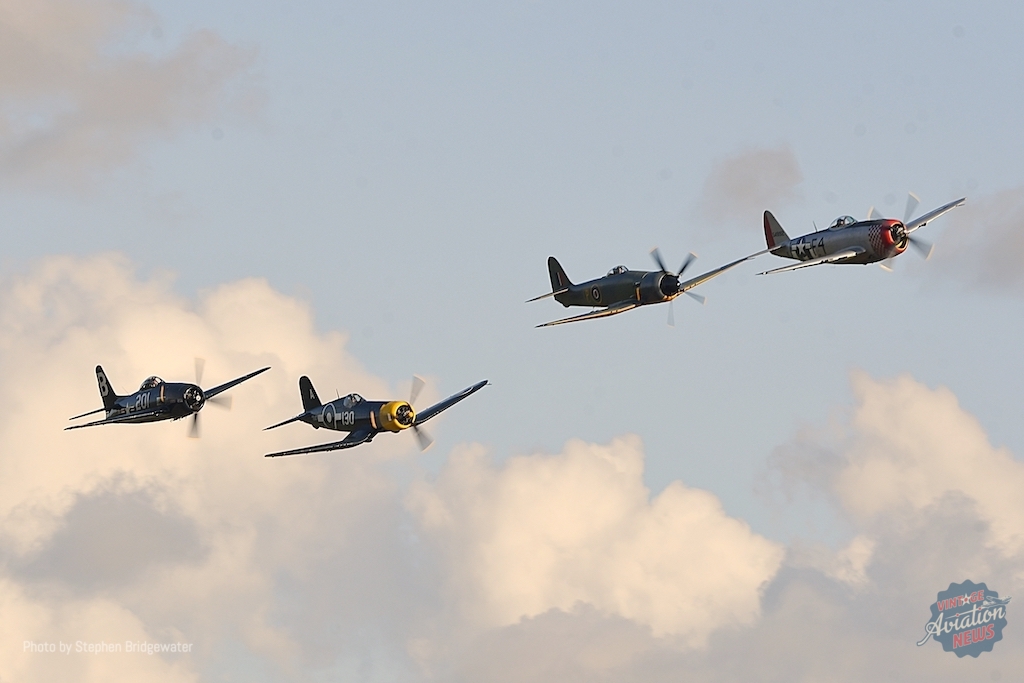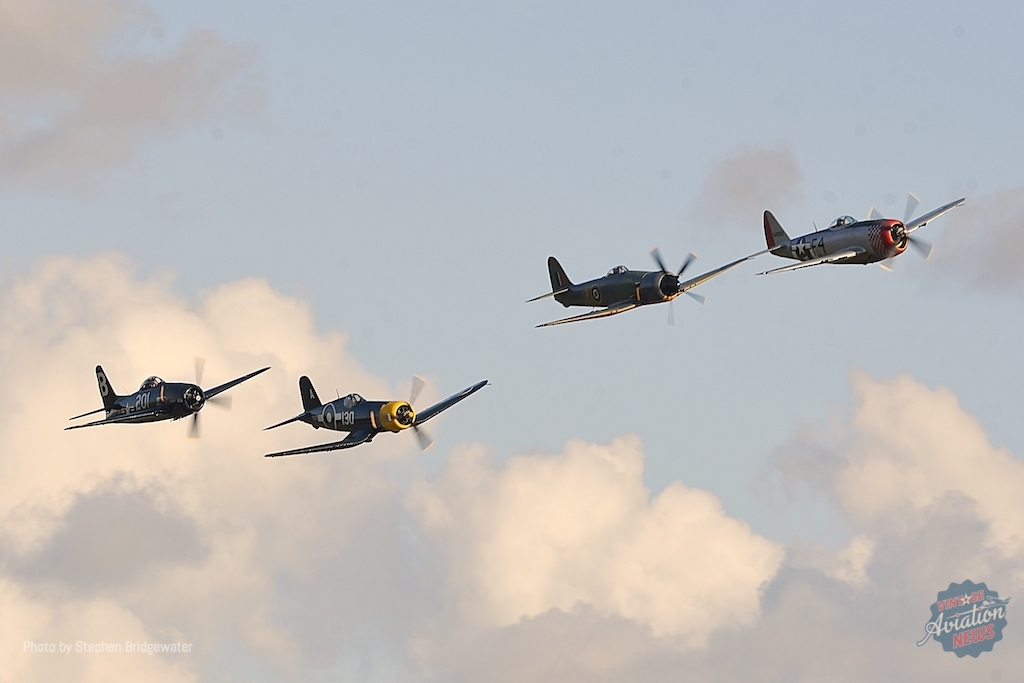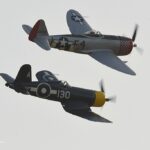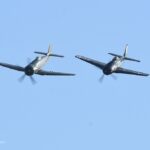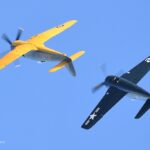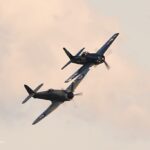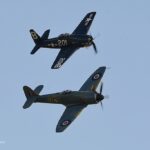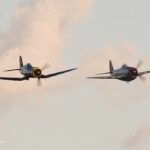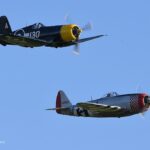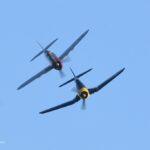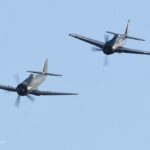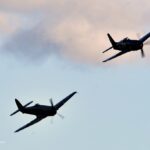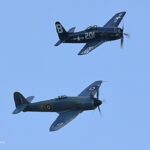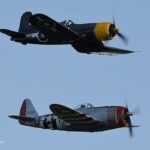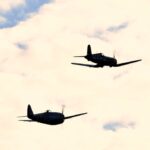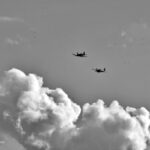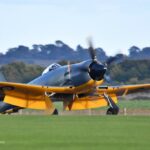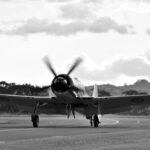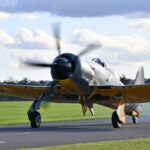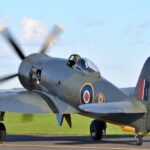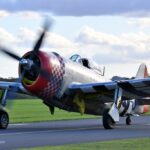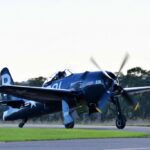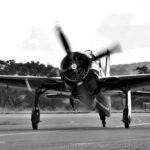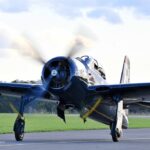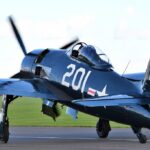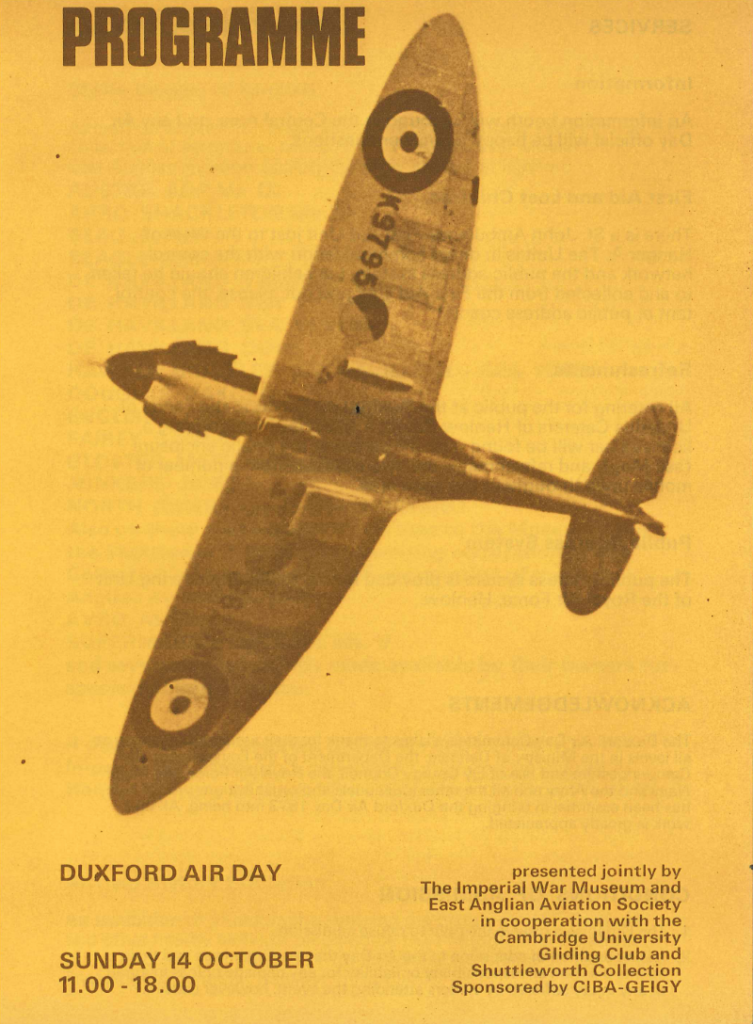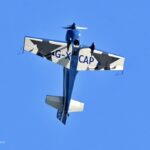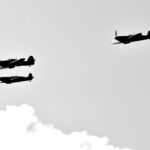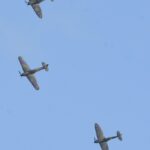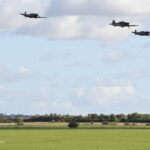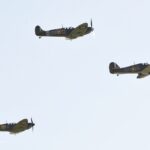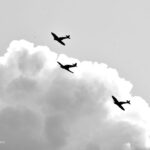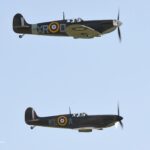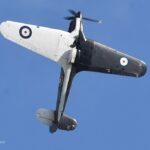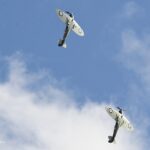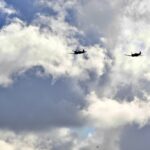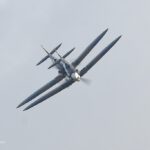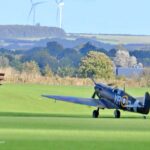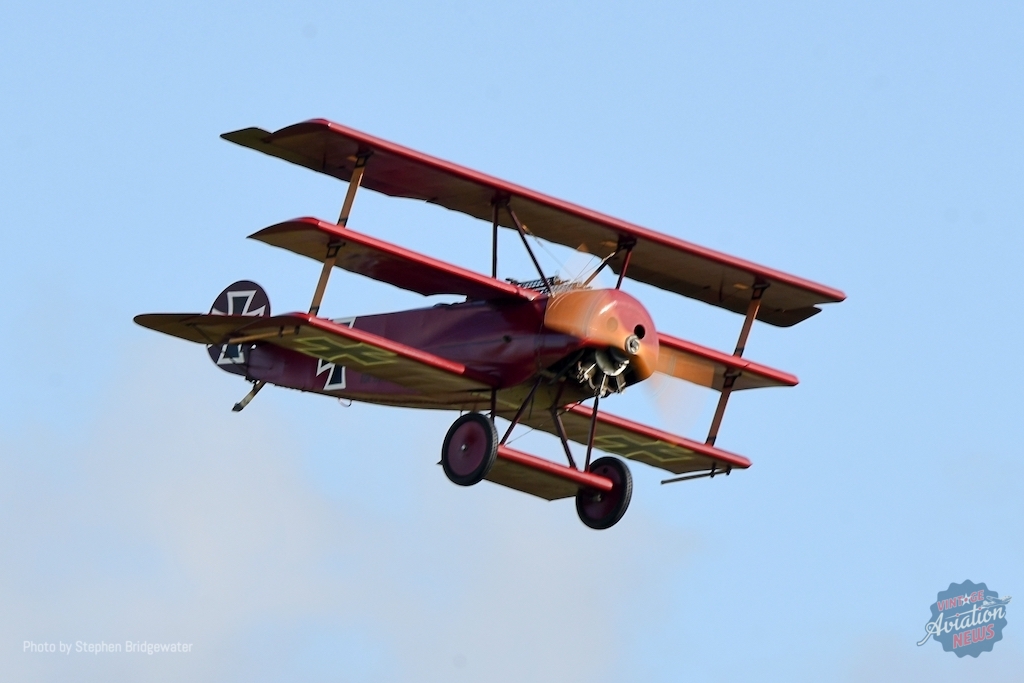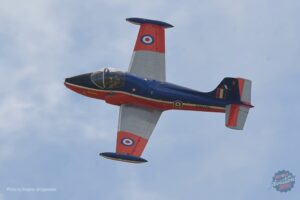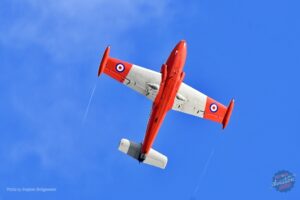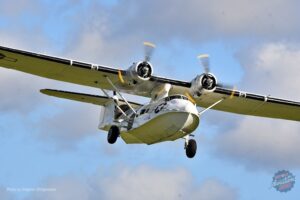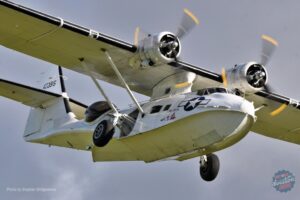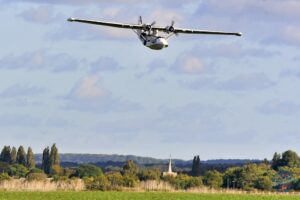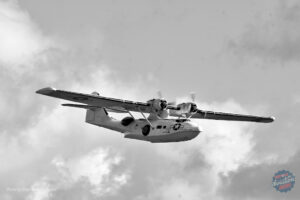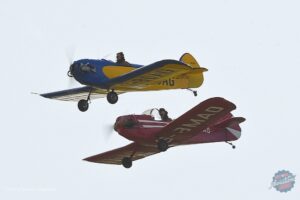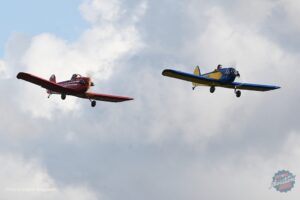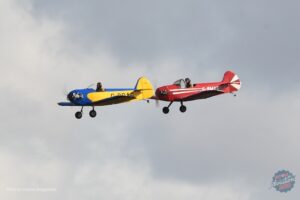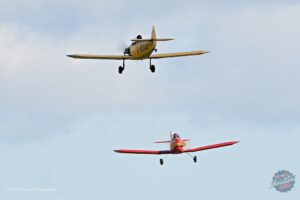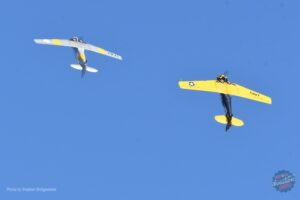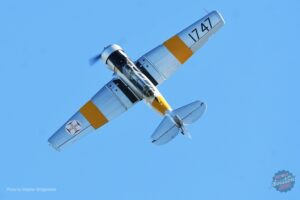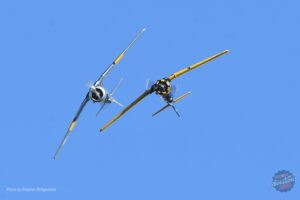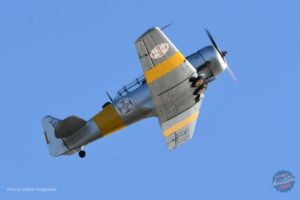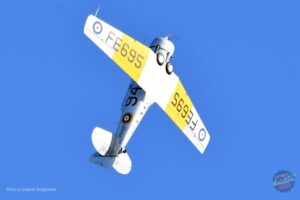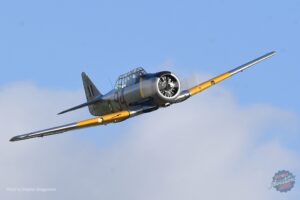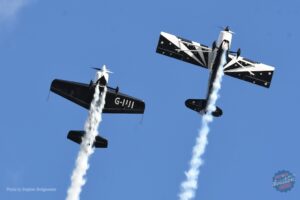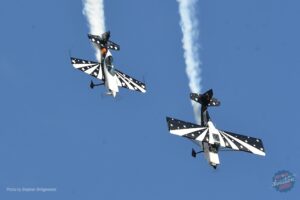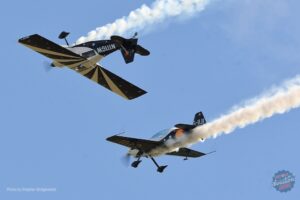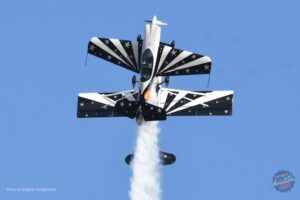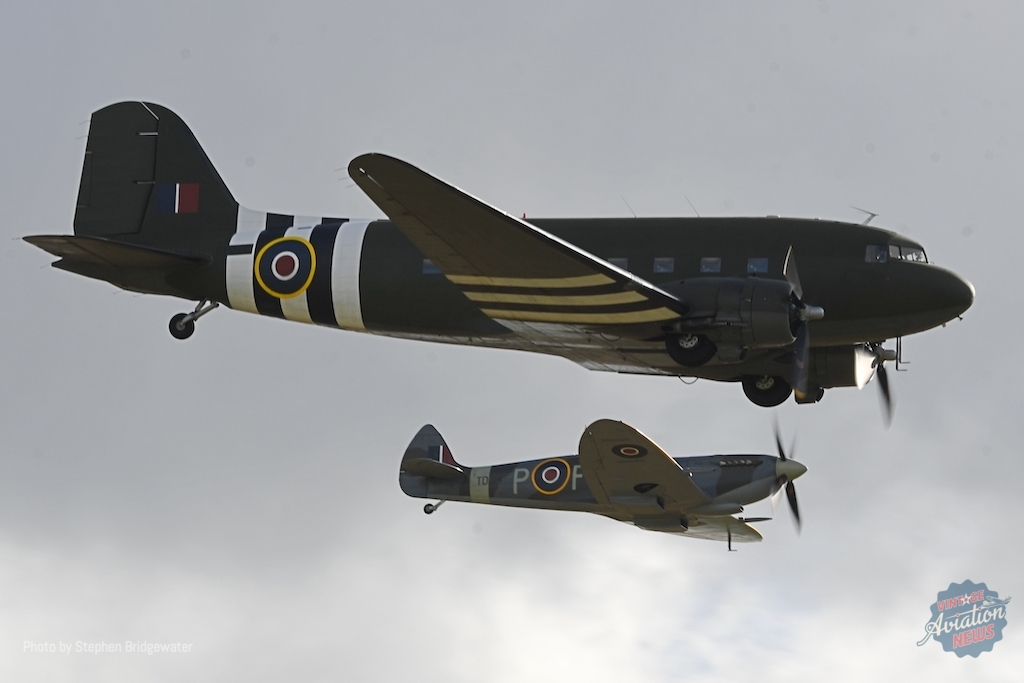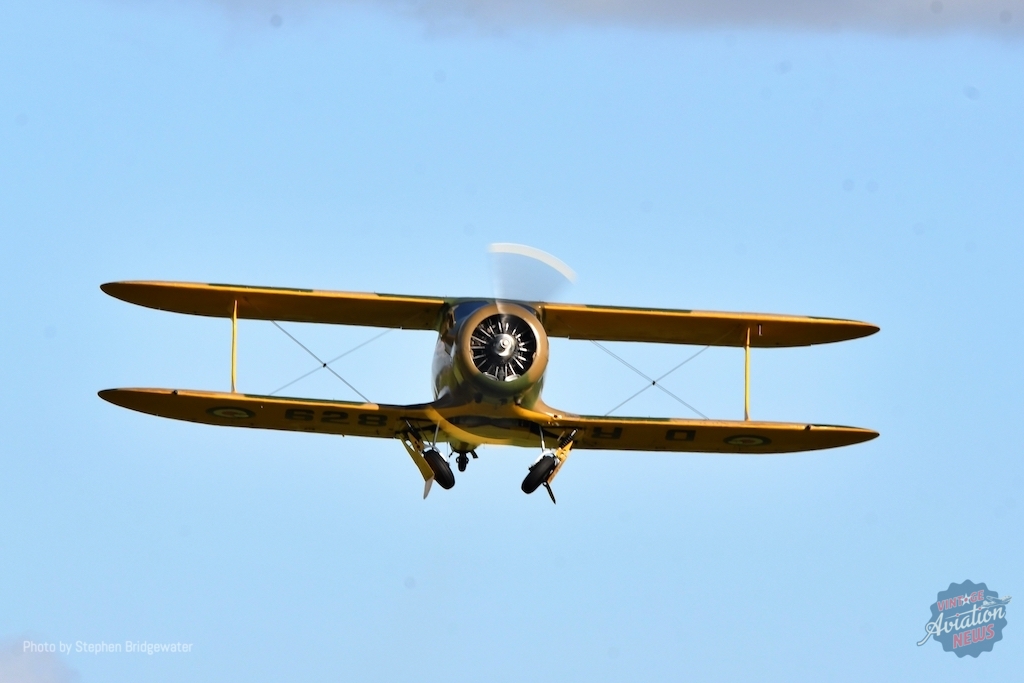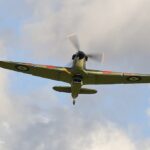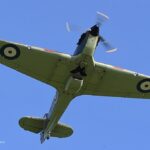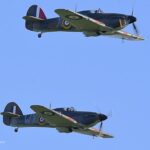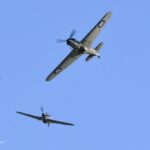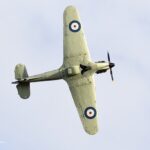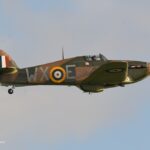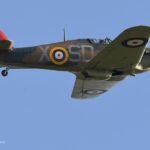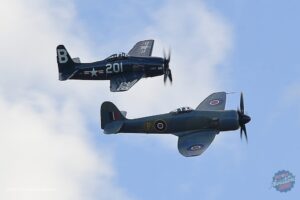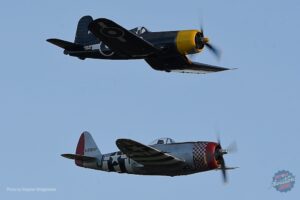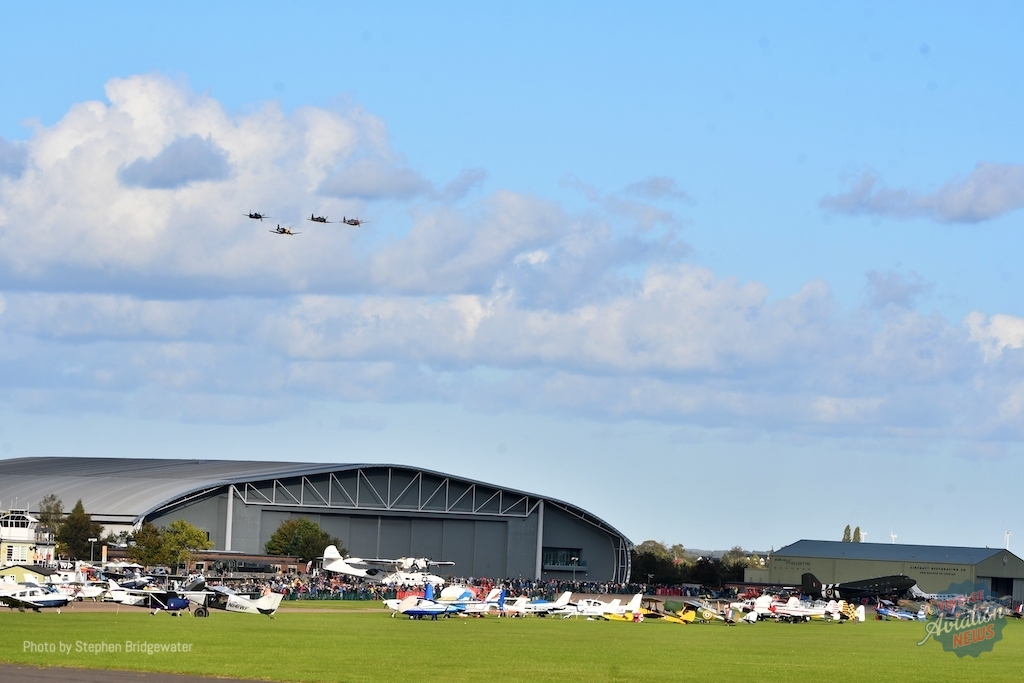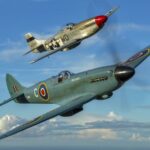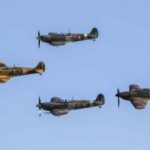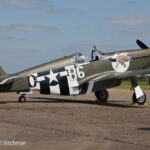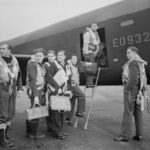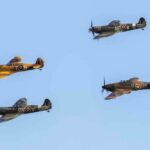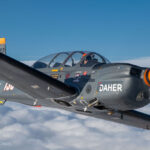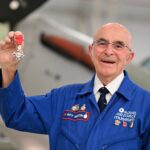By Stephen Bridgewater
As the Bearcat and ISS Fury tail-chased around Duxford airfield, showing the ultimate piston-powered fighters’ power and grace, the P-47 Thunderbolt and FG1D Corsair wheeled around performing elegant aerobatics. It could have been 1988, but it wasn’t. It was October 14, 2023, and the Imperial War Museum (IWM) Duxford was celebrating the 50th anniversary of its first airshow, on the same date in 1973.
All four of these ‘big piston’ fighters have a long association with Duxford, and while the P-47 and Fury have moved on to new owners, the Bearcat and Corsair remain in the stable of The Fighter Collection (TFC). The latter have been resident at Duxford since 1984 and 1986 respectively and on this occasion, they were flown by Brian Smith and Stu Goldspink – pilots with equally impressive associations with Duxford and the UK warbird world.
Meanwhile, the Fury – once owned by John Bradshaw – and the former TFC Thunderbolt have moved on to the ownership of Graham Peacock’s Fighter Engineering, but remain integral to the Duxford warbird scene. For this celebratory event they were flown by Paul Bonhomme and Steve Jones, themselves equally seasoned Duxford warbird pilots as well as Red Bull Air Race legends and aerobatic champions.
That all four pilots come from non-military backgrounds is also symbolic of the British warbird world – where many of the most talented and best-known pilots come from the self-funded, self-improver route.
Duxford at 50
October 14, 1973, was not just the first Duxford airshow, it was the first time that the IWM Duxford site had been opened up to the public. The former RAF Battle of Britain station had become home to the 78th FG during the second half of WWII and in the immediate post-war years had returned to the RAF, behind home to the first generation of jet fighters, including Gloster Meteors and Hawker Hunters. Following closure, it was the scene of much of the filming for the 1969 classic movie Battle of Britain, during which it famously lost one of its hangars to a large pyrotechnic explosion – the film crew succeeding in doing what the Luftwaffe failed to do almost thirty years previously.
Duxford then fell into disrepair and at one point was destined to become a prison, but the IWM stepped in and the rest is history. Today, the site remains a mecca for warbirds and aviation history enthusiasts around the globe.
First Show
That first event in 1973 was a modest affair, with a handful of aircraft from the RAF, Royal Navy, Army Air Corps and civilian operators. The following aircraft are noted as appearing in the flying display element of the show:
Avro Tutor K3215 (G-ASHA) Shuttleworth Collection
Miles Magister P6382 (G-AJRS) Shuttleworth Collection
Percival Provost T.1 XF836 Shuttleworth Collection
Supermarine Spitfire V AB910/QJ-J Battle of Britain Flight
Hawker Hurricane II LF363/LE-D Battle of Britain Flight
Avro Lancaster PA474/KM-B Battle of Britain Flight
Fairey Swordfish LS326/5A Fleet Air Arm
Hawker Sea Fury FB.11 TF956 Fleet Air Arm
Fairey Firefly AS.5 WB271 Fleet Air Arm
De Havilland Mosquito T.3 RR299/HT-E (G-ASKH) Hawker Siddeley Aviation
Gloster Meteor F.8 WH291 RAF 229 OCU
Vickers Varsity T.1 WJ903 RAF 5 FTS
English Electric Canberra B.2 WJ753 RAF 100 Sqn
Hawker Hunter F.6 XG274 RAF 4 FTS (did not land).
Westland Wasp HAS.1 XS567 Royal Navy 829 Sqn (now on display in the museum at Duxford)
Westland Scout AH.1 XV126 Army Air Corps Development & Trials Squadron
Westland Scout AH.1 XV131 Army Air Corps Development & Trials Squadron
Lockheed C-130K Hercules XV185 RAF 24 Sqn.
BAC Jet Provost T.5 XW370 RAF 3 FTS The Geminis Pair
BAC Jet Provost T.5 XW407 RAF 3 FTS The Geminis Pair
BAC Jet Provost T.5 XW410 RAF 3 FTS The Geminis Pair (Spare)
Douglas Dakota G-ANTC Hunting Surveys
De Havilland Dove 6 G-ANUU CAA CAFU
The modern-day IWM aspired to feature as many of those types as possible in the 50th-anniversary celebrations but was hampered by the lack of surviving examples. There are no airworthy examples of the Canberra or Hunter in the UK at the moment and the RAF retired its last C-130 earlier this year. Neither has a Varsity that has not appeared in the skies for many decades.
The BBMF’s season ends in early October, so a repeat appearance by the Lancaster, Spitfire and Hurricane was off the cards. Sadly the FAAHF Sea Fury and Firefly as well as the de Havilland Mosquito have all been lost in accidents and the Shuttleworth Collection’s Provost was subsequently been sold and has not flown for a number of years.
Survivors
Of the Jet Provosts XW370 and XW410 survived as ground instructional airframe at RAF Cosford and XW407 was written off during a non-fatal midair collision in 1986.
Meteor WH291 survives as a static airframe with the Speke Aerodrome Heritage Group and is on display behind the Crowne Plaza Hotel at Liverpool John Lennon Airport, Hunter XG274 is under restoration to static condition by the Suffolk Aviation Heritage Group at Foxhall but Canberra WJ753 was written off in a non-fatal accident at RAF Marham in 1978. Meanwhile, Hercules XV185 was returned to Lockheed Martin in 2001 and subsequently scrapped.
Dove G-ANUU was also scrapped, in this case at Biggin Hill after being retired in 1976 and Varsity WJ903 was scrapped at the Dumfries and Galloway Air Museum in 1987, although its nose section survives at the South Yorkshire Aircraft Museum in Doncaster.
Fittingly, Wasp XS567 now resides in Duxford’s Hangar 4 as a museum piece but of the pair of Scouts XV131 met its end on the fire dump at Middle Wallop in 2001. While Scout XV126 survives in private hands in the UK as G-SCTA, it has sadly not flown in recent years.
The organisers did have options though, with the Shuttleworth Magister, Gladiator and Tutor still regular flyers. Both the ‘Maggie’ and Tutor were therefore booked to attend the 50th anniversary celebrations.
Show Day
Following a week of often abysmal weather, October 14, 2023, dawned bright and dry – albeit it breezy. While the two Shuttleworth Collection aircraft were the only genuine veterans of the first show to be booked, the organisers secured several ‘representative’ types to fill in some of the gaps. These were joined by a smorgasbord of Duxford favourites and – refreshingly – a selection of new acts being given their first chance to display in front of a large audience.
The flying kicked off at 1:00 pm with an impressive display of precision aerobatics by Diana Britten MBE in her Mudry CAP-232, followed by a sight that has become synonymous with Duxford – a Hawker Hurricane and two Spitfire Is. While Hurricane P2902 (G-ROBT) flew a graceful aerobatic display Comanche Fighters’ Spitfires flew a delightful pairs routine. Although Spitfire X4650 (G-CGUK) is a relatively new restoration AR213 (G-AIST) has been a stalwart of British airshows since it was restored for the movie Battle of Britain in 1968. Although it flew from Duxford during the film, it was not one of the aircraft to appear at the first IWM Duxford airshow – however, it has appeared at countless subsequent ones. The inclusion of AR213 set the scene for the appearance of aircraft that have delighted Duxford audiences over the last five decades.
The trip was followed by Paul Ford’s Fokker Triplane replica (G-FOKK), which brought back memories of the late-great Robin Bowes, whose similarly marked aircraft played the Red Baron at countless Duxford airshows in the 1980s and 90s.
Then it was the turn of Chris Heames to delight the crowds with Jet Provost T.5 XW325 (G-BWGF). The rare aerobatic display by a UK classic jet was a real treat, with Chris’ display included as a nod to the appearance of the Gemini Pair. Formed by 3FTS at RAF Leeming in the 1970s the team flew for three seasons, with the 1973 display at Duxford flown by Flt Lts Graham Miller and Clive ‘Bob’ Thomson – the latter an active jet warbird pilot in the 1990s and 2000s.
Another airshow favourite followed in the shape of Plane Sailing’s Consolidated PBY-5A Catalina G-PBYA (actually a Canadian Vickers Canso). Plane Sailing first moved to Duxford in 1985 with its first Catalina (G-BLSC) and G-PBYA has been resident at the IWM’s airfield since 2004. The inclusion of long-term Duxford residents such as this was an important nod to the past, although it was sad that the Old Flying Machine Company’s Spitfire IX MH434 (G-ASJV) and B-17 Preservation’s B-17G Sally B were notably absent from the celebrations – the latter having started its winter maintenance just a week or so before the event.
New talent and old hands
Following the Catalina – and offering a true comparison in size – were the two Taylor Monoplanes of Team Mono. Formed earlier this year by 21-year-old Ben Gilmore and his friend Bruce Buglass, the team flew an impeccable formation, and even their crossovers were at the crowd centre, despite the gusty wind.
Over the decades Duxford has played witness to countless new pilots performing their airshow debuts – from Mark Hanna to Richard Grace and the myriad young pilots now emerging onto the warbird scene such as James Hepnar. It was refreshing to see such young talent being showcased at this 50th-anniversary event, which also included a display debut by Isabel Rutland in the CK Aviation Services T-6 Harvard G-BTXI. The former TFC aeroplane was once a familiar sight at Duxford and Isabel’s solo routine followed a pairs display by Nigel Wilson and airshow veteran Rod Dean in Harvards G-TSIX and G-BGPB ‘Taz’ respectively. Rod has been displaying at airshows since 1972 and has led some of the most memorable formations at Duxford, including the Battle of Britain’s 60th-anniversary formation of in excess of 20 Spitfires and Hurricanes in 2000.
Another new act for 2023 was the Titans Aerobatics Team, with Patrick Wilson and Simon Ansell flying an unusual mixed formation of an American Champion Xtreme Decathlon and an XtremeAir XA42. Having appeared at a couple of events this season this pairing is truly breathtaking and, in the author’s opinion, one of the standout airshow acts in the UK today.
Today, Duxford fulfils an important role in the air display world by allowing ‘tyro’ display pilots and acts with a location to practice and hone their skills. One team that has taken advantage of the opportunity is the Flying Comrades, comprising Duxford-based pilots David Hardisty, Alex Lewton and Tom Turner flying a Yakovlev Yak-18T (G-HUHU) and two Yak-52s (G-BXJB and G-YAKF)
Familiar friends
While DC-3 G-ANTC, which flew in the first IWM airshow – still survives, it flies as HK-3215 with Aerolíneas del Llano in Colombia – so it was perhaps a little beyond the economical ferrying range for an airshow appearance! Nevertheless, there was another Dakota at Duxford on October 14, 1973.
Ex-RAF Dakota KP220 had flown during the Berlin Airlift in 1948-49 with 24 Sqn and following service was struck off in 1950. Flown as G-ANAF by BKS Air Transport from 1953 it joined Hunting Surveys in November 1958 but in April 1973 it was retired and flown to Duxford for preservation by the East Anglian Aviation Society. The stripped-down aircraft was on show to the public within one of Duxford’s hangars during the first airshow but by 1977 it had been sold to and revived by Air Atlantique.
Used variously as a passenger aircraft, freighter, pollution control sprayer and even as a radar test airframe, G-ANAF was sold to Aero Legends in 2019 and appeared at Duxford’s 50th-anniversary airshow in the markings of an RAF D-Day Dakota. In the hands of Andrew Dixon, G-ANAF was joined in the air by Aero Legends’ Spitfire IX TD314 (G-CGYJ), which was flown by Charlie Brown.
Another Spitfire followed it into the skies in the shape of Rolls-Royce’s PR.XIX PS853 (G-RRGN). Visiting from East Midlands Airport, the former BBMF-owned airframe was a suitable nod to the BBMF’s varied appearances at Duxford over the decades – and on this occasion was flown by former BBMF Officer Commander Sqn Ldr Mark ‘Disco’ Discombe MBE.
Another familiar friend returned to Duxford for the anniversary show in the hands of (relatively) new owner Peter Kuypers. Beechcraft Staggerwing N18V was owned and operated from Duxford by warbird pioneer Robs Lamplough between 1979 and 1982 in the markings of an example flown by Prince Bernhard of The Netherlands. Peter acquired the aeroplane in 2021 and now uses it when commuting from the Netherlands to Duxford.
Sadly, the Shuttleworth Collection’s Avro Tutor became unserviceable and was unable to join the celebrations, but the same Miles Magister that had appeared on October 14, 1973, graced the skies on October 14, 2023. Joining it, as a last-minute replacement for the sick Tutor, was a second Magister. Built for the RAF in 1941 as V1075, this aircraft later became G-AKPF and was also at Duxford for that first event, albeit in pieces in the hangar. Owned at the time by the East Anglian Aviation Association, visitors to the show could have their photograph taken in the cockpit. It would be 1991 before Adrian Brook returned ‘Papa Fox’ to the skies and today it is based at Old Warden alongside the Shuttleworth Collection example. Flown by syndicate member Dave Bramwell it flew a coordinated display with G-AJRS flown by Jean-Michel Munn.
Never in your dreams
If one could travel back in time and speak to the visitors to the 1973 Duxford Airshow about their expectations for the future, few would have dreamt that three Hawker Hurricanes would fly a formation display fifty years later. Back then, just three Hurricanes were airworthy in the world – PZ865 and LF363 with the BBMF and G-AWLW with the Strathallan Collection in Scotland. The latter would be exported to Canada in 1984 (and was tragically lost in a hangar fire nine years later) and it would be 1990 before TFC’s G-HURI would take to the skies.
Today, thanks in no small part to the efforts of Hawker Restorations, the world’s airworthy Hurricane population stands well into double figures, with five examples regularly calling Duxford home.
For the 50th anniversary airshow, the former TFC Hurricane XII G-HURI (which has been operated from Duxford by the Historic Aircraft Collection since 1999) flew alongside two newly recreated Hurricane Is. Fighter Aviation Engineering’s P2902 returned to the air for its second slot of the day, this time joined by the Hurricane 501 syndicate’s V7497 (G-HRLI).
Returning to those 1973 attendees, perhaps even fewer of them would have imagined that airworthy examples of both the Hurricane’s predecessor and successor would be on display at the airfield five decades later. Although they did not take part in the afternoon flying display, the Historic Aircraft Collection’s 1935 Hawker Fury K5674 (G-CBZP) did conduct an air test during the morning and was then parked alongside the newly-flown Hawker Tempest II MW763/G-TEMT, which had arrived at Duxford at the conclusion of its maiden flight from Sywell just a few days previously. The opportunity to see a flyable Fury, Hurricane, Tempest and Sea Fury on one airfield really is a dream come true for historic aviation enthusiasts.
Flying Finale
All too soon, it was time to assemble the aircraft for the finale of Duxford’s 2023 airshow season. As previously described, the choice to fly the Thunderbolt, (Sea) Fury, Bearcat and Corsair was inspired. The display, which was choreographed and led by Paul Bonhomme, was a joy to behold and brought back memories of Duxford airshows of the past.
It was easy to allow one’s thoughts to drift and remember Stephen Grey and the much-missed Ray Hanna ‘duelling’ in the Bearcat and the old OFMC Iraqi Fury or the late ‘Hoof’ Proudfoot beating up the airfield in the Thunderbolt.
It was unfortunate that Spitfire MH434 – which is surely ‘the’ most iconic Duxford warbird – was unable to join them, nor the ex-Robs Lamplough Mustang Miss Helen (G-BIXL), B-17 Preservation’s Sally B, the Grace Spitfire (ML407) or a heavy metal fighter from the Aircraft Restoration Company (and its predecessor the British Aerial Museum). All of these organisations have played an integral role in making Duxford the ‘mecca’ that it has become.
There were certainly some missed opportunities at what could have been a truly spectacular event. However, there were enough ‘old friends’ to spark nostalgia and bring back memories of the heyday of British airshows.







